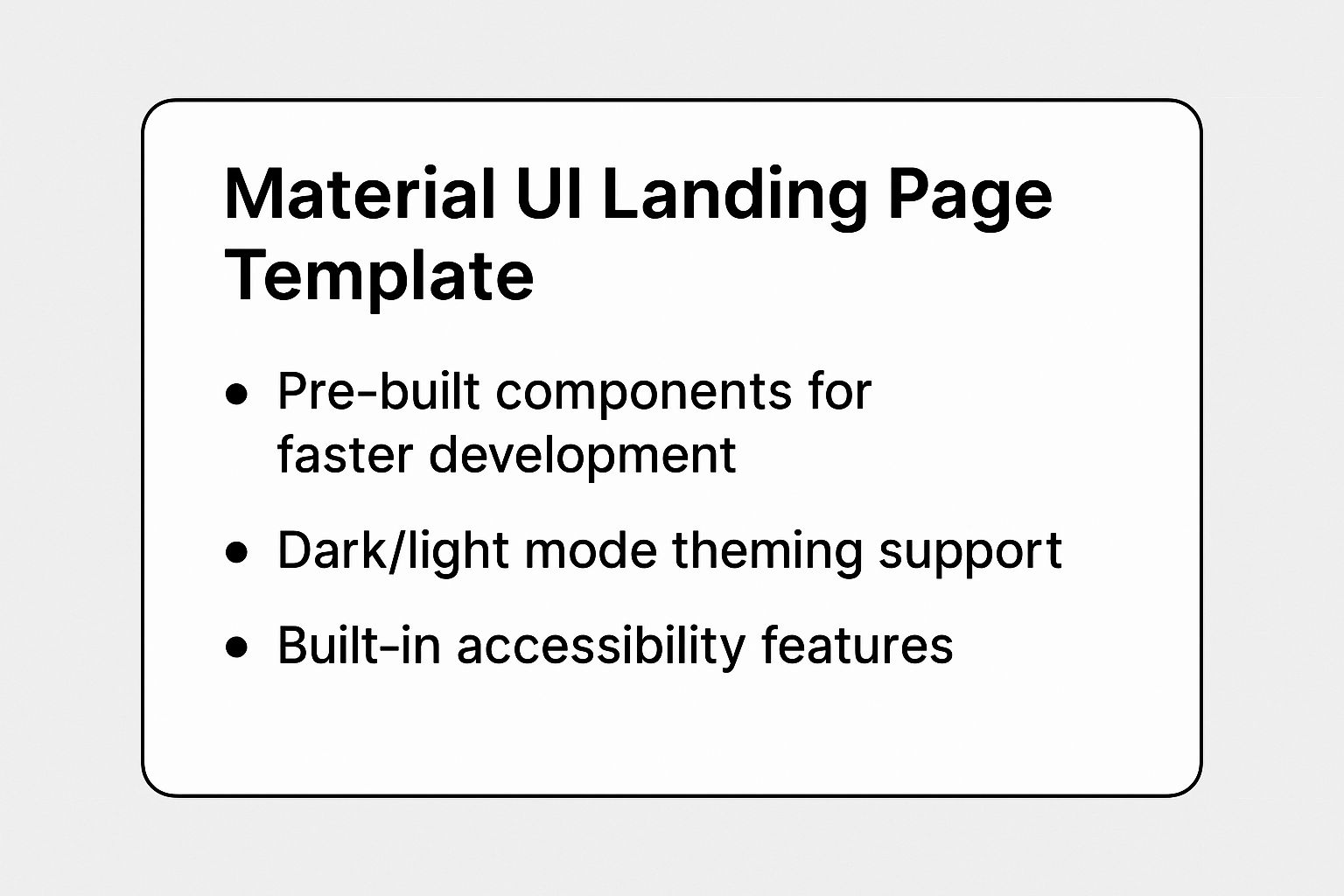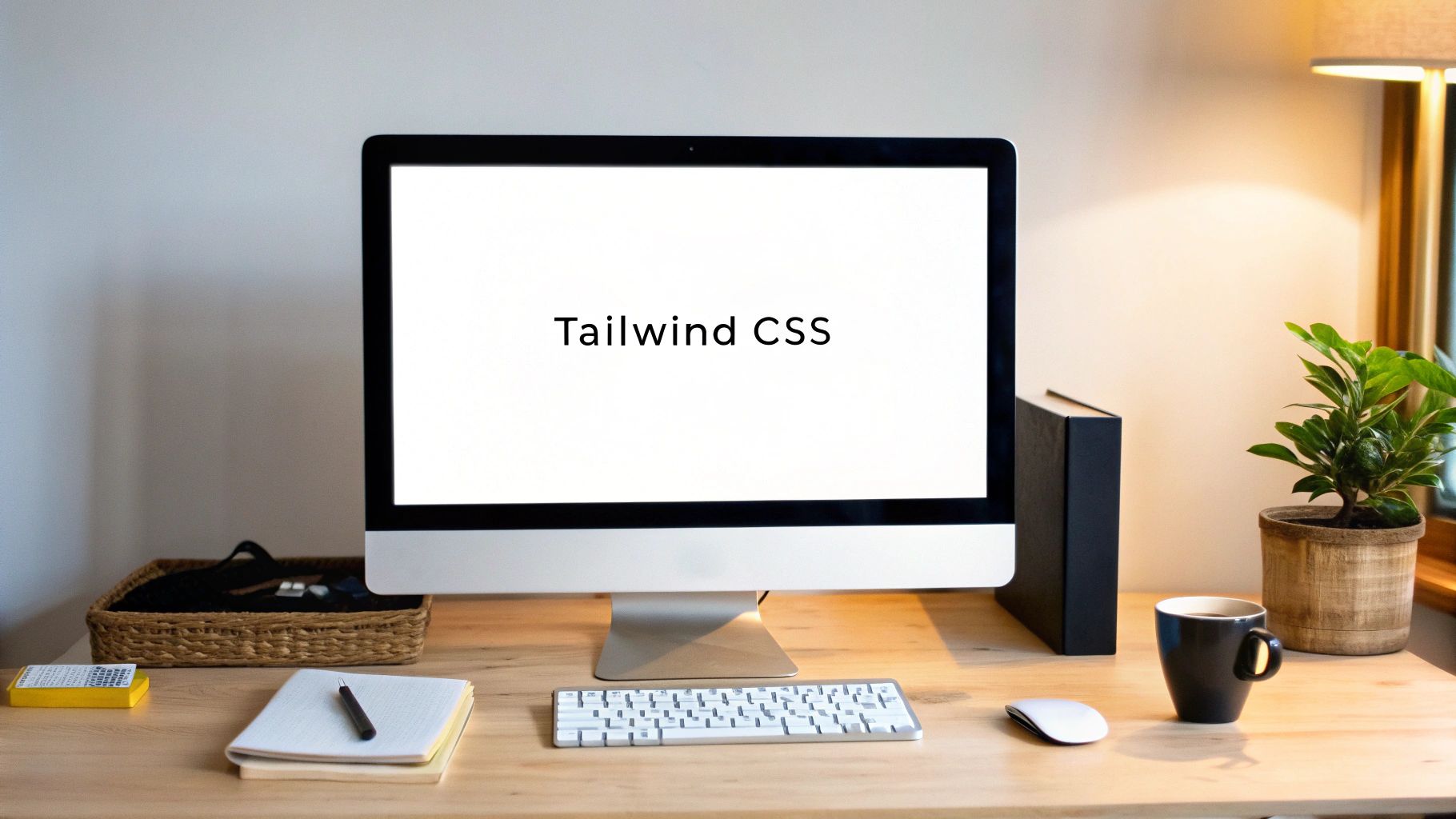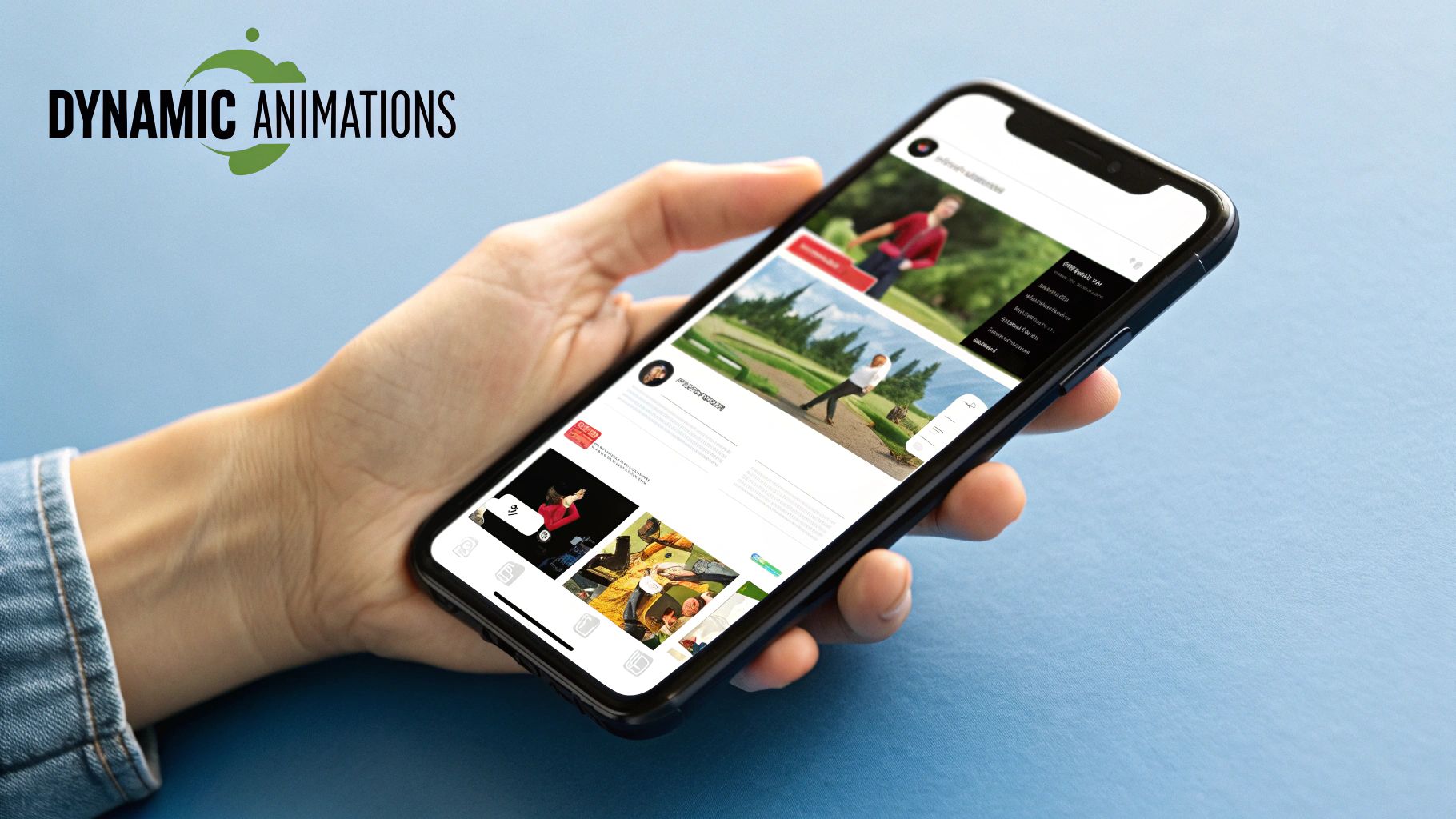react landing page
landing page design
react templates
web development
ui design
Top React Landing Page Examples to Boost Conversions
Level Up Your Landing Pages with React
Want to build a high-converting React landing page? This listicle provides six effective approaches using popular frameworks and UI libraries. Learn how to create stunning, performant landing pages with tools like Material UI, Tailwind CSS, Gatsby, Next.js, Framer Motion, and Chakra UI. These examples demonstrate various design techniques and best practices for maximizing visitor engagement and achieving your marketing goals with a React landing page. Discover the perfect approach for your next project and boost your conversions.
1. Material UI Landing Page Template
Building a compelling and effective react landing page is crucial for attracting users and converting them into customers. Leveraging pre-built templates can significantly streamline this process, and a popular choice among developers is the Material UI Landing Page Template. This comprehensive template utilizes the Material UI framework, offering a modern, responsive design system adhering to Google's Material Design principles. It provides a clean, professional aesthetic, extensive customization options, and a robust set of pre-built components, making it a strong contender for developers of all levels. This approach allows businesses and developers to quickly set up visually appealing and functional landing pages without starting from scratch.

The infographic above summarizes the key advantages of using a Material UI landing page template: rapid development due to pre-built components, a consistent design language across the entire page, and the backing of a large community for support and continuous improvement. These factors contribute to a faster time-to-market and a more polished final product.
The Material UI Landing Page template comes packed with features designed to expedite development. These include pre-built Material UI components like buttons, forms, and navigation menus, a responsive grid layout system ensuring adaptability across various screen sizes, built-in dark/light mode theming for user preference, and reusable section components (hero, features, pricing, testimonials) that can be easily assembled and customized. Furthermore, the template is optimized for performance with code splitting, reducing initial load times and enhancing the user experience.
Examples of successful implementations include the Onepirate Landing Page by Material UI itself, showcasing the framework's capabilities, and the Minimal Pro template used by companies like Devias, demonstrating its adaptability for real-world applications. Material Kit React by Creative Tim is another popular example. These examples highlight the versatility and professional look achievable with this approach.
Pros:
- Extensive component library saves development time: Quickly build complex layouts using pre-designed components.
- Consistent design language across all elements: Maintain a cohesive visual identity with minimal effort.
- Strong community support and documentation: Access ample resources and assistance for troubleshooting and learning.
- Built-in accessibility features: Cater to a wider audience with pre-configured accessibility considerations.
- Easy theme customization through Material UI's theming system: Adapt the look and feel to match your brand with simple theming options.
Cons:
- Can look generic without significant customization: Requires effort to differentiate your landing page from others.
- Larger bundle size compared to minimal templates: Can impact initial load times if not optimized correctly.
- Learning curve for Material UI's styling approach: Requires familiarity with Material UI's specific styling conventions.
- May require additional work to create unique brand identity: Customization is essential to avoid a generic appearance.
Tips for effective implementation:
- Customize the color palette to match your brand: Create a consistent brand experience.
- Replace placeholder images with high-quality visuals: Enhance visual appeal and professionalism.
- Utilize Material UI's theming to maintain consistency: Ensure a uniform look and feel throughout the page.
- Implement lazy loading for performance optimization: Improve initial load times by loading components only when needed.
- Use
React.memofor components that don't need frequent re-rendering: Optimize performance by preventing unnecessary re-renders.
This template is ideal for independent developers and hobbyists looking for a quick and easy way to create a professional landing page, startup founders and entrepreneurs seeking a fast time-to-market, freelance agencies and consultants working on client projects, product managers and technical leads looking for established design systems, and even AI enthusiasts and prototypers needing a robust front-end for showcasing their projects. Its ease of use, coupled with its extensive feature set and customization options, makes it a valuable tool for anyone seeking to build a high-quality react landing page efficiently. The popularity of this approach is largely due to the efforts of Google's Material Design team, the Material UI development team, and template providers like Creative Tim, who have made the framework accessible and readily available.
2. Tailwind CSS React Landing Page
Building a compelling react landing page requires a thoughtful approach to styling. A popular and efficient method leverages the power of Tailwind CSS, a utility-first CSS framework. This approach emphasizes flexibility and customization through low-level utility classes, providing a minimalist foundation that can be extensively customized without battling against pre-defined component styles. Instead of relying on pre-built components, you apply individual utility classes directly to your HTML elements. This gives you granular control over every aspect of your landing page's design, allowing you to create unique and visually appealing experiences with minimal custom CSS.

Tailwind CSS offers a variety of features that make it well-suited for react landing page development. Its utility-first nature means you have a comprehensive set of pre-defined CSS classes at your fingertips, covering everything from spacing and typography to responsive design and animations. This results in a highly customizable system with minimal overhead, allowing rapid prototyping and iteration. Furthermore, Tailwind CSS is designed with performance in mind. Features like PurgeCSS integration contribute to a small bundle size, optimizing your react landing page for fast loading times. This modern design aesthetic, often featuring subtle animations, can significantly enhance the user experience. For those interested in further exploration, you can learn more about Tailwind CSS React Landing Page.
Several successful examples demonstrate the effectiveness of Tailwind CSS for react landing pages. Projects like Tailwind Starter Kit by Creative Tim, Tailblocks by Mert Cukuren, and adapted Tailwind UI templates provide excellent starting points and inspiration. These resources showcase the framework's versatility and demonstrate how it can be used to create visually appealing and functional landing pages.
To maximize your effectiveness with Tailwind CSS for your react landing page, consider these actionable tips: Create reusable component abstractions for frequently used patterns to maintain consistency and reduce redundancy. Leverage Tailwind's @apply directive to extract and reuse complex utility class combinations, keeping your HTML cleaner. For accessible and interactive components, consider integrating with Headless UI. Implement theme switching, including dark mode, using Tailwind's built-in capabilities. Finally, libraries like clsx or classnames can streamline conditional class application within your React components.
This approach is particularly beneficial for independent developers, hobbyists, startup founders, freelance agencies, and product managers seeking rapid development, extensive customization, and optimized performance. Its flexibility makes it ideal for creating unique designs that stand out. AI enthusiasts and prototypers can also leverage Tailwind's speed and customization to quickly bring their visions to life.
Pros:
- Extremely flexible without writing custom CSS.
- Better performance due to smaller bundle size.
- No need to context-switch between CSS files and component code.
- Consistent spacing and design tokens.
- Easier to create unique designs compared to component libraries.
Cons:
- HTML can become cluttered with utility classes.
- Steeper learning curve for Tailwind-specific syntax.
- Requires more manual work to create complex components.
- May need additional libraries for advanced interactive elements.
Tailwind CSS has been popularized by figures like Adam Wathan (Tailwind CSS creator), Steve Schoger (Refactoring UI author), and the Tailwind Labs team. Their contributions and advocacy have significantly contributed to the widespread adoption and success of this framework within the web development community. Using Tailwind CSS for your react landing page empowers you to create visually stunning, high-performing, and highly customizable experiences.
3. Gatsby React Landing Page Starters
For those seeking blazing-fast performance and top-notch SEO for their React landing page, Gatsby React Landing Page Starters offer a compelling solution. Leveraging the power of static site generation (SSG), these starters combine React's component model with Gatsby's robust data layer and build optimization, resulting in highly performant, marketing-focused landing pages. This approach is particularly well-suited for creating a react landing page that needs to make a strong first impression and rank well in search engine results.
Gatsby generates static HTML files during the build process. This means that instead of dynamically rendering content on the server for each request, the pre-built HTML is served directly to the user's browser. This drastically reduces page load times, a crucial factor for both user experience and SEO. Furthermore, Gatsby's data layer, powered by GraphQL, allows you to seamlessly integrate data from various sources (CMS, APIs, databases) and structure it efficiently for your landing page.
Features:
- Static site generation for improved performance: Pre-built HTML ensures rapid page loads.
- Built-in image optimization and lazy loading: Optimized images further enhance performance.
- GraphQL data layer integration: Structure data from multiple sources efficiently.
- SEO-optimized with structured data: Improve search engine visibility and ranking.
- Progressive Web App (PWA) capabilities: Enable offline access and enhance user experience.
Pros:
- Exceptional page load performance: SSG leads to significantly faster loading times compared to server-side rendering.
- Superior SEO capabilities out of the box: Static content is easily crawlable by search engines. Gatsby's structured data features further enhance SEO.
- Rich plugin ecosystem for additional functionality: Extend Gatsby's capabilities with a wide range of plugins.
- Pre-rendering improves First Contentful Paint metrics: Delivers content to users quickly, improving perceived performance.
- Seamless content management system (CMS) integration: Connect to headless CMS platforms for simplified content management.
Cons:
- Build time increases with site complexity: Larger sites can take longer to build.
- Steeper learning curve due to GraphQL and Gatsby concepts: Requires familiarity with Gatsby's architecture and GraphQL.
- Dynamic content requires additional configuration: While Gatsby excels at static content, dynamic elements require careful implementation using client-side JavaScript or serverless functions.
- May be overkill for very simple landing pages: For extremely basic landing pages, a simpler React setup might suffice.
Examples:
- Gatsby Starter Landing Page by Gatsby team: A basic starter for building landing pages.
- Gatsby Starter SaaS Marketing by Thrive Digital: A starter tailored for SaaS marketing pages.
- Gatsby Dimension starter: Widely used for product launches, this starter offers advanced features.
Tips:
- Use
gatsby-imagefor automatic image optimization: Optimize images effortlessly with Gatsby's image plugin. - Implement structured data for better SEO: Enhance search engine understanding of your content.
- Connect to a headless CMS for easy content management: Streamline content updates and management.
- Utilize Gatsby Functions for serverless API endpoints: Add dynamic functionality without managing servers.
- Implement incremental builds for faster deployment: Speed up build times for subsequent deployments.
Popularized By:
- Kyle Mathews (Gatsby creator)
- Gatsby, Inc. team
- Jason Lengstorf (developer advocate)
Gatsby React Landing Page Starters deserve a place in this list because they provide a powerful and performant approach to building react landing pages. The combination of React's flexibility and Gatsby's optimization capabilities offers a robust solution for developers and businesses looking to create high-converting landing pages that rank well in search results. While there is a learning curve involved, the benefits of improved performance and SEO make Gatsby an excellent choice for building a professional and effective react landing page. For independent developers, startup founders, freelance agencies, and product managers alike, Gatsby starters offer a streamlined pathway to building impactful landing pages. Even AI enthusiasts and prototypers can benefit from Gatsby’s robust infrastructure when showcasing their projects with a fast, responsive, and SEO-friendly landing page.
4. Next.js React Landing Page Templates
Next.js has become a popular choice for building high-performance React landing pages. These server-side rendered (SSR) templates leverage the component-based architecture of React while offering the performance benefits of server-rendered HTML. This approach bridges the gap between dynamic content needs and fast loading times, crucial for engaging landing pages. This makes Next.js a powerful option for anyone from independent developers and hobbyists to startup founders, freelance agencies, and even product managers looking to create effective and optimized landing pages.
Next.js works by pre-rendering pages on the server. This means that when a user requests your page, they receive a fully formed HTML document, resulting in significantly faster initial load times compared to client-side rendered React apps. This server-side rendering is also a boon for SEO, as search engine crawlers can easily index the content. Furthermore, Next.js offers Static Site Generation (SSG) for content that doesn't change frequently, providing even greater performance boosts. For dynamic content, Incremental Static Regeneration (ISR) allows you to update static pages after they've been generated, offering a balance between performance and fresh content.
Features that make Next.js stand out:
- Server-side rendering (SSR) and Static Site Generation (SSG): Choose the best rendering strategy for each page based on its content.
- Automatic code splitting and bundling: Optimized bundles for faster loading times.
- API routes for backend functionality: Easily create serverless functions for handling form submissions, data fetching, and other backend tasks.
- Image optimization with
next/image: Automatic image resizing and optimization based on device and network conditions. - Incremental Static Regeneration for dynamic content: Keep content fresh without sacrificing performance.
Pros:
- Better SEO than client-side rendered React: Server-rendered HTML makes it easier for search engines to index content.
- Fast page loads with server-rendered HTML: Improved user experience and conversion rates.
- Simplified routing system: File-based routing makes navigation management straightforward.
- Excellent developer experience with hot reloading: Fast feedback loop during development.
- Vercel deployment integration for easy hosting: Streamlined deployment process.
Cons:
- More complex architecture than pure React: Requires understanding of server-side concepts.
- Server component may introduce hosting complexities: Setting up and managing a server can be more involved.
- May require Node.js knowledge for advanced customization: Deeper customization may necessitate Node.js expertise.
- Some third-party React libraries need adaptation for SSR: Ensure compatibility with server-side rendering.
Examples of Next.js Landing Pages:
- NextJS Landing Page Template by Cruip: A beautifully designed template showcasing the capabilities of Next.js.
- Vercel Marketing Site: Built with Next.js, Vercel's own marketing site serves as a prime example of the framework's power.
- Precedent by Steven Tey (Next.js 13 starter): A solid starting point for building modern Next.js applications.
Tips for Building Effective Next.js Landing Pages:
- Use
getStaticPropsfor content that doesn't change often: Maximize performance with static generation. - Implement Incremental Static Regeneration for dynamic content: Balance freshness and speed.
- Leverage
next/imagefor automatic image optimization: Improve page load times and user experience. - Create reusable layout components for consistent page structure: Maintain a consistent design and branding across your landing page.
- Utilize Next.js middleware for authentication or localization: Add advanced functionality to your landing pages.
Next.js's popularity is largely due to the Vercel team (formerly Zeit), including Guillermo Rauch (Vercel CEO) and Lee Robinson (Vercel developer advocate), who have championed its development and adoption. It’s a powerful framework that deserves its place in the list due to its ability to create performant and SEO-friendly React landing pages. For entrepreneurs and product managers, this translates to faster iterations and better results. Learn more about Next.js React Landing Page Templates This resource might offer valuable insights into validating startup ideas, a crucial step before building a landing page. By combining the dynamic nature of React with server-side rendering, Next.js provides a robust and efficient solution for building modern landing pages that convert.
5. Framer Motion React Landing Page
For React landing pages that prioritize user engagement and dynamic visuals, Framer Motion offers a powerful solution. This approach leverages the Framer Motion library, a popular animation library for React, to create interactive and visually appealing experiences. Framer Motion allows developers to implement a wide variety of animations, from subtle transitions to complex micro-interactions, breathing life into static content and capturing user attention. This translates to a more memorable brand impression and can significantly improve user engagement, a critical factor for converting visitors into customers.

Framer Motion facilitates declarative animations and transitions, enabling developers to define animations directly within their React components. This makes animations easier to manage and integrate with the overall application logic. Its rich feature set includes scroll-triggered animations, bringing elements to life as the user scrolls down the page, and interactive gesture animations, allowing users to engage directly with the page elements through clicks, hovers, and other interactions. Furthermore, Framer Motion enables impactful page transition effects and sophisticated SVG path animations, giving developers the tools to create truly unique and engaging experiences. Think of it as adding a layer of polished interactivity, elevating your react landing page beyond the static and expected.
Features:
- Declarative animations and transitions
- Scroll-triggered animations
- Interactive gesture animations
- Page transition effects
- SVG path animations for illustrations
Pros:
- Creates engaging user experiences that increase conversion
- Animations enhance storytelling capabilities
- Smooth 60fps performance with hardware acceleration
- Accessible animations with reduced-motion support
- Developer-friendly API compared to CSS animations
Cons:
- Can impact performance if overused
- Requires careful implementation to avoid motion sickness
- May distract from content if not strategically implemented
- Additional library increases bundle size
Examples of Successful Implementation:
- Framer Motion Templates by ui8.net
- Linear.app website (uses Framer Motion extensively)
- Stripe.com landing pages (similar animation philosophy)
Tips for Implementation:
- Use the
useInViewhook for scroll-triggered animations: This hook allows you to trigger animations when an element enters the viewport, creating dynamic reveals as the user scrolls. - Implement exit animations for smoother user experience: Don't just animate elements on entry; use exit animations to create a more polished and cohesive feel.
- Add motion preferences support for accessibility: Respect user preferences for reduced motion to ensure inclusivity.
- Create reusable animation variants for consistency: Define reusable animation variants to maintain a consistent animation style throughout your landing page.
- Use layout animations for responsive elements: Leverage layout animations to create smooth transitions when elements resize or reposition due to changes in screen size.
Popularized By:
- Matt Perry (Framer Motion creator)
- Framer team
- Pabbly (popular animation-heavy templates)
When and Why to Use This Approach:
A Framer Motion-powered React landing page is particularly effective for products or services that benefit from visual storytelling and interactive demonstrations. This approach is ideal for startups, SaaS companies, and creative agencies seeking to create a strong first impression and differentiate themselves from the competition. It’s especially relevant for audiences who appreciate modern design and engaging user experiences. While not suitable for every project, specifically those where performance is paramount or design aesthetics call for a more minimalist approach, Framer Motion provides a significant advantage when crafting memorable and engaging react landing pages. Remember to balance the desire for engaging animations with the need for optimal performance and clear, concise communication of your core message.
6. Chakra UI React Landing Page
Building a compelling and effective landing page is crucial for any online venture. If you're working with React, a popular choice for front-end development, Chakra UI offers a powerful component-based approach to streamline the process of creating React landing pages. This approach balances design flexibility and rapid development, all while prioritizing accessibility and offering powerful theming capabilities, making it a strong contender for building your next React landing page.
Chakra UI is a modular and accessible component library that provides pre-built React components like buttons, forms, and layout elements. These components are designed to be composable, meaning you can combine them in countless ways to create complex UIs. Its accessibility features ensure your landing page is usable by everyone, regardless of their abilities. Moreover, the theme-based styling system, using design tokens, makes it remarkably easy to manage and adapt the visual appearance of your landing page. This system facilitates consistent spacing, typography, and overall aesthetics.
One of Chakra UI's standout features is its built-in support for dark/light mode switching, catering to user preferences and modern design trends. Responsive design is also simplified with array syntax, allowing you to define styles for different viewports with ease. Furthermore, the use of style props provides a quick and convenient way to customize individual components without delving into complex CSS.
Features:
- Composable and accessible component system
- Theme-based styling with design tokens
- Dark/light mode switching built-in
- Responsive design with array syntax
- Style props for quick customization
Pros:
- First-class accessibility support
- Consistent spacing and typography
- Faster development with a comprehensive component library
- Flexible theming without CSS files
- Better developer experience than direct CSS
Cons:
- Less widespread adoption than Material UI
- Can lead to prop-heavy component code
- Styling approach differs from traditional CSS workflows
- Less opinionated design language requires more design decisions
Examples:
- Chakra Templates (free collection of landing page templates)
- SaaS UI Pro by Appulse
- Horizon UI Dashboard adapted for landing pages
Tips for Using Chakra UI for React Landing Pages:
- Customize the theme: Match the theme to your brand identity for a consistent brand experience.
- Use responsive array syntax: Adapt your landing page layout and styles for different screen sizes using Chakra's array syntax.
- Leverage the Box component: Avoid unnecessary div nesting by using the versatile Box component for layout and styling.
- Implement color mode toggle: Provide users with the option to switch between light and dark modes for enhanced accessibility and user preference support.
- Create a component library: Build reusable UI components specific to your design patterns for consistency and maintainability across your project.
Popularized By:
- Segun Adebayo (Chakra UI creator)
- Chakra UI open source community
- Vercel team (advocates and users)
This approach is particularly well-suited for independent developers, hobbyists, startup founders, freelance agencies, and product managers looking to quickly build and deploy attractive, accessible React landing pages. The ease of theming, accessibility features, and component library significantly reduce development time. If you're looking for a boost in productivity and a seamless design workflow, Chakra UI is definitely worth exploring. Learn more about Chakra UI React Landing Page It empowers developers, from AI enthusiasts prototyping new ideas to experienced technical leads building complex applications, to create robust and polished react landing pages efficiently. Its focus on developer experience makes it an appealing option for those looking to move away from the complexities of direct CSS and embrace a more component-driven workflow. This is why Chakra UI deserves its spot on this list of effective methods for building a react landing page.
React Landing Page Templates Comparison
| Template | Core Features / Highlights | User Experience / Quality ★★★★☆ | Value & Pricing 💰 | Target Audience 👥 | Unique Selling Points ✨ |
|---|---|---|---|---|---|
| Material UI Landing Page Template | Pre-built Material UI components, Dark/light mode, Accessibility | Consistent, professional, performance-optimized | Free + Premium ($49-99) | Businesses & Developers | Google's Material Design, strong docs 🏆 |
| Tailwind CSS React Landing Page | Utility-first CSS, Highly customizable, Small bundle | Flexible, minimalist, great performance | Mostly free / open-source | Developers wanting custom design | Low overhead, highly flexible ✨ |
| Gatsby React Landing Page Starters | Static site generation, SEO optimized, GraphQL data | Exceptional SEO & load speed | Free / open-source | Marketers, content-heavy sites | Static generation + PWA, CMS integrations 🏆 |
| Next.js React Landing Page Templates | SSR & SSG, API routes, Incremental Static Regeneration | Fast SEO, dynamic content support | Free / open-source | Startups needing dynamic SSR | SSR+SSG hybrid, easy Vercel deployment 🏆 |
| Framer Motion React Landing Page | Declarative & gesture animations, Scroll triggers | Engaging, smooth animations, can impact performance | Free / open-source | UX-focused teams, brand storytellers | Physics-based animations, interactive ✨ |
| Chakra UI React Landing Page | Accessible components, Theming, Dark/light mode | Accessible, consistent, developer-friendly | Free / open-source | Accessibility-focused devs | WAI-ARIA compliant, theme flexibility ✨ |
Ready to Build Your Dream React Landing Page?
This article has explored six powerful approaches to crafting effective React landing pages, ranging from leveraging component libraries like Material UI and Chakra UI to utilizing the flexibility of Tailwind CSS and the performance benefits of Gatsby and Next.js. We also touched on how incorporating animation with Framer Motion can add a touch of dynamism to your design. The key takeaway is to choose the framework and tools that best align with your project's specific needs and your team's expertise. Mastering these techniques empowers you to create engaging, high-performing landing pages that capture leads and drive conversions. A well-crafted React landing page isn't just a digital storefront; it's a powerful tool for achieving your business objectives, whether that's launching a new product, growing your user base, or establishing your brand presence.
Looking for more landing page inspiration specifically for SaaS products? Check out this curated list of the best SaaS landing pages of 2025 from Bookmarkify for insights into current design trends and best practices. This resource can provide additional inspiration and help you craft a landing page that truly resonates with your target audience.
Building a high-converting React landing page for your SaaS project can be even easier with the right tools. Explore AnotherWrapper, a Next.js-powered platform designed to help you launch AI-powered micro SaaS ventures quickly and efficiently, complete with pre-built components and integrations to streamline your development process.
Fekri




